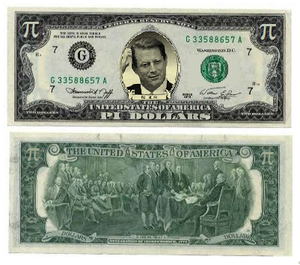UnNews:U.S. pi-dollar bill on the rise
7 November 2006

NEW YORK, New York -- America's little-known $π bill, once confined to the displays of currency collectors and the desk drawers of eccentric mathematicians, is gaining acceptance as its use increases in mainstream transactions.
In 2005, as newly released U.S. Treasury reports show, depository institutions ordered around $72 billion in $π bills, more than seven times as much as seven years ago in 1999, when the bill was released.
The introduction of the $π was rather quietly passed by Congress in August of 1999 and approved by President Clinton later that year. It had been pushed for by a cadre of scientific- and mathematic-community special interest groups for several years prior. The bill depicts then-Vice President and presidential candidate Al Gore, honoring the politician for his singlehanded creation of the Internet and discovery of mathematics and circular measure. While the bill's initial few years were slow, owing largely to the discouragement of the majority at the fact that the bill represented a non-integer, irrational number of dollars, since the turn of the century more and more early adopters and younger, tech-savvy buyers have embraced the quirky bill.
The $π bill, however, has also received harsh criticism, owing in particular to its value, which fluctuates in different areas of the United States. While most of the country agrees that the bill represents a dollar amount matching the mathematically calculated value of π, 3.14159..., in most southern states it is only valued at $3.
Reverend Billy Tackerton of the Mobile, Alabama Southern Baptist Convention explained the reasoning behind the apparent regional inflation. "Simply put, the Bible says that God decreed a circle's circumference is exactly 3, and that's all there is to it. In the First Book of Kings, chapter seven, verse 23, God tells the people that a round basin should have a 10 cubit diameter and be 30 cubits around. You can fling as many fancy-schmancy proofs as you want at me, all I know is you faggoty nerd types better get to scratching your pencils, because someone done made a mistake in their calculations. Pi is 3, and that's that."
Economic analysts are worried that this inconsistency may lead to more harm than the bill's designers anticipated. Already, seven men have been convicted, in separate cases, of fraud for amassing truckfuls of $π bills in southern states and cashing them at northern banks for a profit, and fifteen more cases are awaiting trial.
Another problem with the $π bill in Texas is that the people, who are mostly ignorant of mathematics, believe that the bill is edible. Cases of mass disappearances of $π bills has spurred the Texas government to issue press releases asking citizens to stop eating the π, although so far these measures seem only to have worsened the problem.
Yet, for the most part, retailers are continuing to see more and more $π bills in circulation, and by some estimates they're now more common than $100 and $2 bills and are closing in on the $50. Regardless of the risk their use may involve, there's no doubt that the irrational $π bill is ramping up in terms of public acceptance. This may ultimately speed the oft-proposed introductions of the newly minted e-cent coin (not to be confused with the Euro Cent) and the dollar bill. Although the bill's release has been the subject of a complex debate, for now it’s just imaginary.
Source[edit | edit source]
- Michael Flaherty "U.S. pi-dollar bill gains popularity" Reuters, November 6, 2006
